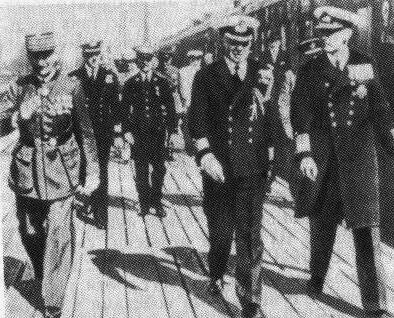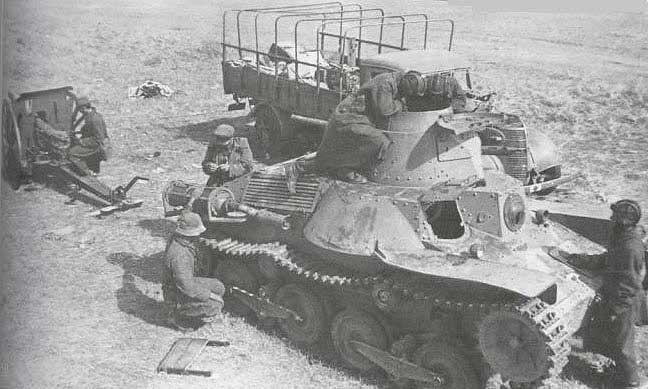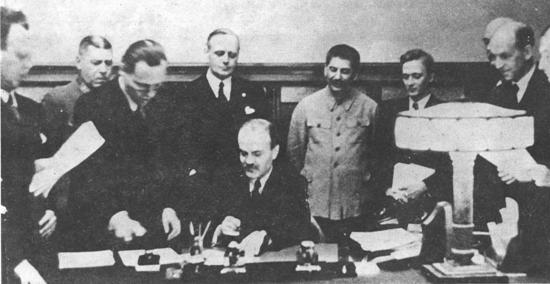How Did Soviet Foreign Policy Change After 1945
§ 43. USSR in international relations on the eve ofWorld War
one.The policy of collective security
For20-30'southward Soviet policy has undergone significant changes. Realizing impracticabilitysoon the world revolution, the Soviet leadership sought exitinternational isolation.
Duringworld economic crisis of the USSR sought to use the contradictions betweencapitalist countries to ensure the kickoff five-year transformation.It before long became clear that the actions of Germany and Nihon threaten the security of the USSR. Itchanged its strange policy doctrine. The threat from Nihon, forced the Soviet Uniongo closer to Chiang Kai-shek and to recommend CCP to human action together in Homindanomagainst Japan.
Soviet Union madeby a system of collective security and deterrence aggressors. ConductorThis grade became the People'southward Commissar for Foreign Affairs of the USSR G. Litvinov. USSRmanaged to consolidate their position. In 1933 established diplomaticrelations with the U.S., and in 1934 The USSR was adopted in the League of Nations equally a member of the Boardwhich meant the recognition of his great power.
Success inby creating a organization of collective security was the determination in 1935Soviet-French agreement on common assist. However, information technology wasno war article, just in any case the agreement opened the way tojoint struggle against the aggressor. A similar agreement in 1935 was concludedwith Czechoslovakia.

French mission to the Red Army maneuvers
AttitudeWestern countries to create a system of collective security was cool.Soviet-French agreement was ratified by France only a year.Doubts raised above all that the Soviet Wedlock has no mutual edge with Germanyand to fulfill their obligations? Soviet troops would crossto Poland and Romania. But these countries feared the Soviet Union more than? than Federal republic of germany? andcategorically refused to miss the Soviets. In the French consistedimpression that the USSR would drag France into conflict with Germany, and the verystay away. When the Due west became known effects of repression in the SovietArmy, the military machine alliance with the USSR roztsinyuvavsya as meaningless.
2.Changing strange policy of the USSR. Soviet-German non-assailment pact andsecret protocol to it.
In Munichfully demonstrated inability of the Soviet leadership to create a systemcollective security. Soviet-French-Soviet and Czechoslovak agreementswere simple piece of paper. For the Soviet leadership was Munichsignal that information technology wants to eliminate from participation in European affairs.
SoonFrance and Federal republic of germany concluded an agreement, equivalent non-aggression pact. USSR assessedis an endeavour to send the W German assailment e.
The defeat of the USSRon the European diplomatic front was held against the backdrop of deteriorating relations withJapan, which resulted in a conflict almost Lake Hassan in July 1938 AccordingSoviet leadership? Soviet Union was the prospect of aggression from the E andWest.

Soviet soldier sets a standard in soptsiZaozerna as a symbol of victory in battle nearly Lake Hassan
Losthope for the possibility of establishing a commonage security system, being inpolitical isolation, mistrust proynyavshys to England and French republic, the SovietUser starts searching for ways rapprochement with Germany. An important feature ofchanges in Soviet foreign policy orientation was replaced Litvinov asCommissar for Foreign Affairs. Became the new Commissar Molotov (May 1939), andit meant that Stalin himself is set to guide foreign policy.

Molotov

Litvinov
Fracture inSoviet foreign policy coincided with the beginning of a policy of Western countries. USSRmoving from England and French republic to Frg and England and France sought rapprochementwith the USSR.
England andFrance, concerned about their unexpected developments, fabricated statements aboutguarantees a series of European countries - Poland, Romania, Belgium,The netherlands, Switzerland and others. Guarantees new situation in Europe. Germanycould not accept the assailment against the USSR, without violating the sovereignty of Poland andRomania and, appropriately, risking not find itself at war with England andFrance.
In March1939 England invited the USSR to sign together with France and PolandUniversal Declaration on the interaction. In April 1939 Western Statesturned to the Soviet Marriage with a proposal to guarantee Poland and Romania.
In responseUSSR proposed pact of common aid between England, France and the USSRwhile providing safeguards to the edge with the Soviet Union states. Butnegotiations began on the subject, proved hard because of common distrustbetween participants and parties unwillingness to compromise. Parties failed toovercome disagreements on the issue of "indirect assailment. England and French republic saw informulating Soviet threat to the sovereignty of its neighboring states, sothat any change in the border states of the Soviet Union could be qualifiedSoviet leadership as aggression in that location would be introduced, and the Soviets. ToBesides England considered these talks equally a ways of pressure on Germany and did not wantagreement.
Together withpolitical negotiations between Britain, French republic and the Soviet Marriage agreed to start negotiationsmilitary missions to enter into joint convention. They too wereineffective.

ArrivalEnglish and French armed forces missions to participate in negotiations Muskvi(August 1939)
Formalobstacle to signing the convention was the unwillingness of Poland and Romaniaskip through their territories of the Soviet troops. True - SovietFind studied the issue of rapprochement with Frg.
In August1939 USSR was in the center of world politics. His commitmentdemanded as England with French republic and Deutschland. Before the Soviet leadershipwas the problem of choosing the final landmark on which depended the fate of the world.
AccordingStalin's brotherhood with Britain and France, at best, could bring tensionsrelations with Deutschland, and at worst, a war with Hezbollah. Marriage left the same with GermanySoviet Union would temporarily bated global disharmonize. One would expectcessation of hostilities with Nihon on the River Halhin-Chief (there were from May toAugust 1939 in the MNR), which would affect only Germany,territorial acquisition at the expense of Poland, the Baltic States, Finland and Romania.

SovietJapanese soldiers examine seized equipment in the fighting on the river Halhin-Chief
Germany wasagree to this if but to bring the Soviet Matrimony out of the game and unleash its hands for aggressionagainst Poland, who was appointed on August 26 and and then on September 1.
August 21Stalin received a telegram from Hitler, in which he stated that seeks tosigning non-aggression pact with the Soviet Union and is ready to sign whatsoever additionalagreement that applies to all controversial issues. Hitler asked for MinisterGerman Strange Minister Ribbentrop to sign the relevant documents.
On the same dayStalin gave the order to append the negotiations with Britain and France, butobstavyvshy is as if the Soviet Marriage not guilty of disrupting them, and sent a telegram to Hitlerexpressing hopes for a significant turnaround in the Soviet-German relations. HeRibbentrop agreed to accept the deadline. Soviet intelligenceexactly knew almost Hitler'south plans for an attack on Poland.

Signing Pact Ribbentrop а and Molotov а
Aftershort talks Ribbentrop and Molotov signed in the Kremlin August 231939 not-assailment pact and a hugger-mugger protocol to information technology.
InThe Parties agreed on the delimitation of "spheres of involvement 'inEastern Europe. Germany recognized the Soviet sphere of interests of Finland, Latvia,Estonia and Becsarabiyu. Lithuania declared to the High german sphere of involvement. Protocolinvolved the distribution of Poland. Dividing line should be approximatelyNarew, Wisla, Xiang.
Contentdocuments signed in Moscow conspicuously revealed the nature of reorientation of foreignPolicy of the USSR. The essence of this rotation was not piece of cake to changeforeign policy orientations and not simply was limited to attempts to ensuresecurity through straight relations with Germany.
Secretprotocol testified That USSR finally returned to the policy pursued by the Tsarist government: itsfeatures were hole-and-corner diplomacy and territorial expansion. By signing the protocol,USSR was actually among the states - Arsonists War.



Cartoons ofSoviet-German treaty
The immediateresult of the signing of these documents was that the German troops in the forenoon 1September 1939 assault against Poland. September 3 Britain and Francedeclared state of war on Germany. Outbreak of World War Ii.
Pact andadditional protocol and had an influence on Japanese-German relations. Nippon regardedthese documents as a betrayal of Federal republic of germany and after the terminal attack on the USSR refused hersupport. In addition, Japan has ceased its aggression confronting the MNR (armedconflict Nippon and the USSR on the river Halhin-Chief).
Documents and materials
Clandestine Additional Protocol to the non-aggression pact betweenGermany and the Wedlock of Soviet Socialist Republics. August 231939
Signing not-assailment pact between Frg and the UnionSoviet Socialist Republics, the undersigned authorized both sidesdiscussed in a strictly confidential affair of partitioning of spheresmutual interests in Eastern Europe.
This give-and-take led to the results follows:
ane. In the case of territorial and political pereoblashtuvannyaareas that are part of the Baltic States (Finland, Estonia,Latvia, Republic of lithuania), Lithuania's northern border is also beneath the area of interestGermany and the USSR. Thus the interests of Lithuania Vilensky region recognizedParties.
2. In the case of territorial and political pereoblashtuvannyaareas that are part of the Polish land, the edge areas of interest in GermanyUSSR and stretches roughly forth the line Narew year, Vistula and San. The question whethermutual interest in preserving desirable independent Smooth land and to be the borders of this state tin befinally been settled only for the further political development. In eachIf the two governments will decide the effect in a friendly mode reciprocalconsent.
three. For s-e Europe from the Soviet sideemphasizes the interest of the USSR in Bessarabia. On the German language side claimedits complete political disinterestedness in these areas.
4. This protocol shall be deposited past both parties in strictsecret.
Moscow, August 231939
According to the Committee for the Government of the USSRMolotov
For the Authorities of GermanyJ. Ribbentrop.
Inquiries to document
one. Whatwas caused by the appearance of this document?
2. Givemoral and historical evaluation of this protocol.
Questions and Tasks
ane. Whatchanges occurred in the politics of the USSR in xxx years?
2. Whatproblems caused disputes betwixt the USSR and the West during thenegotiations?
3. Giveevaluation of the undercover protocol to the not-aggression treaty between the USSR and Germany.
4. Asconsisted of Soviet-German relations betwixt the ii world wars?
five. What are the causes of armedUSSR conflict with Japan in 1938 and 1939
half dozen. What is the interrelation Communications between the Covenantnon-aggression pact between Germany and the Soviet Wedlock and the conflict between the USSR and Japan onHalhin-Naked?
Note the dates:
1934 - AdoptionUSSR to the League of Nations.
July 1938 - Sino-Sovietconflict near Lake Hassan.
May-August 1939 - Armed conflictbetween the USSR and Japan MNR River Halhin-Chief.
August 23, 1939 - Signing PactMolotovaRibbentropa and secret protocol to it.
September i, 1939 - Home Д ruhoyi World War.
Source: https://geomap.com.ua/en-wh10/1289.html
Posted by: encisosups1996.blogspot.com


0 Response to "How Did Soviet Foreign Policy Change After 1945"
Post a Comment